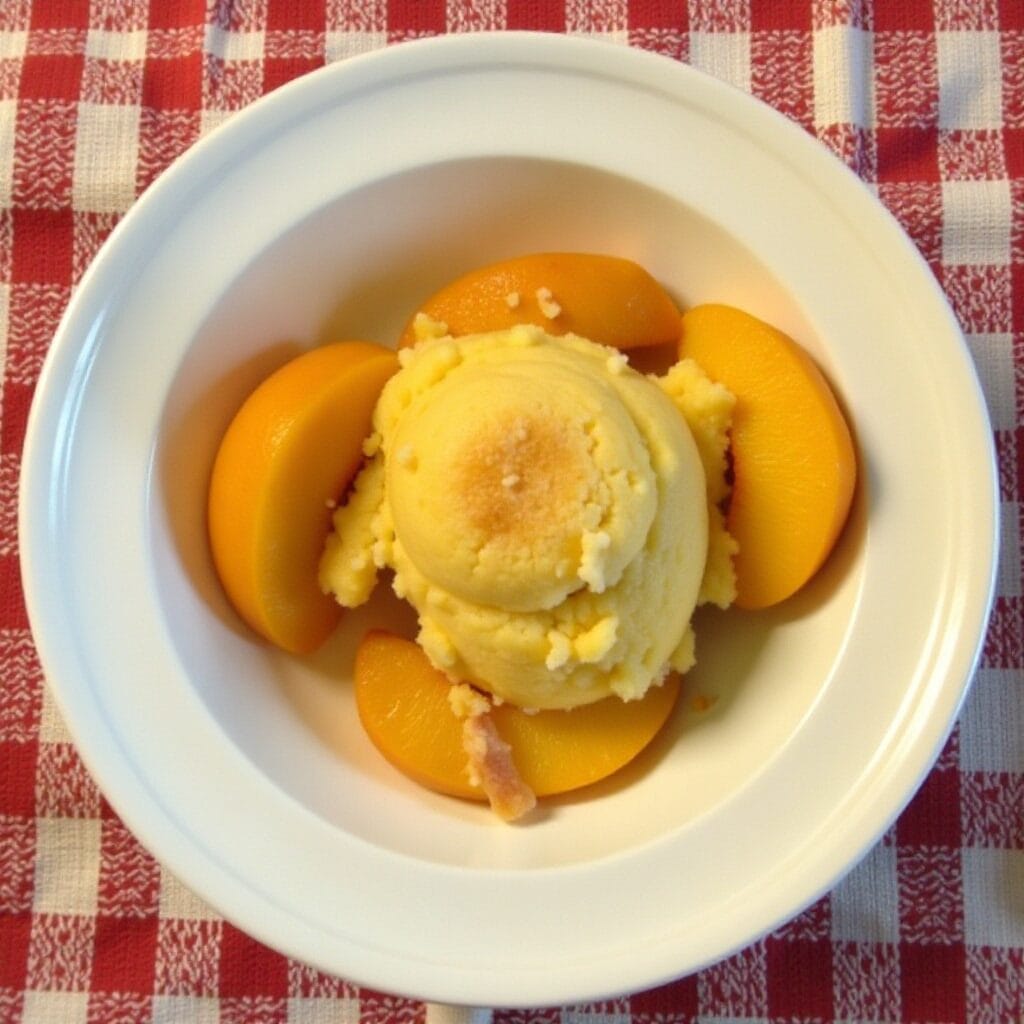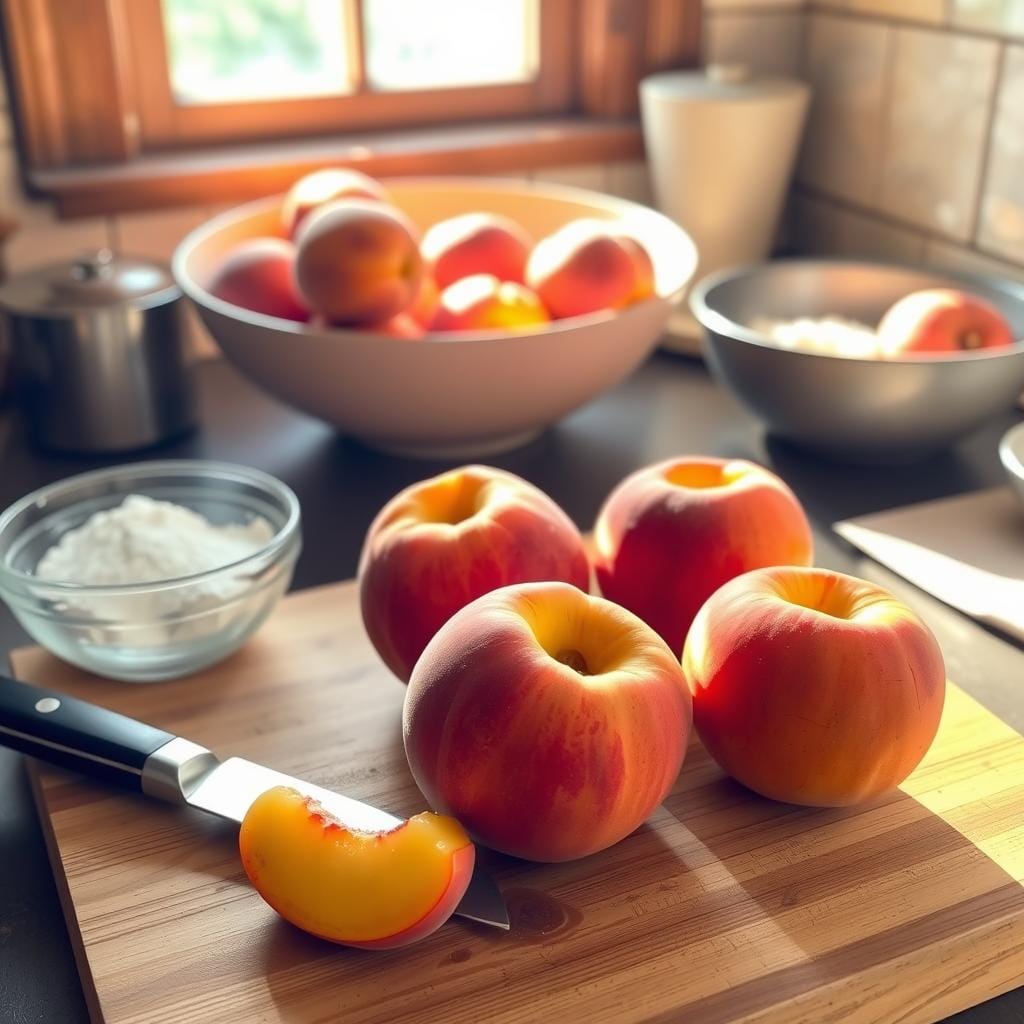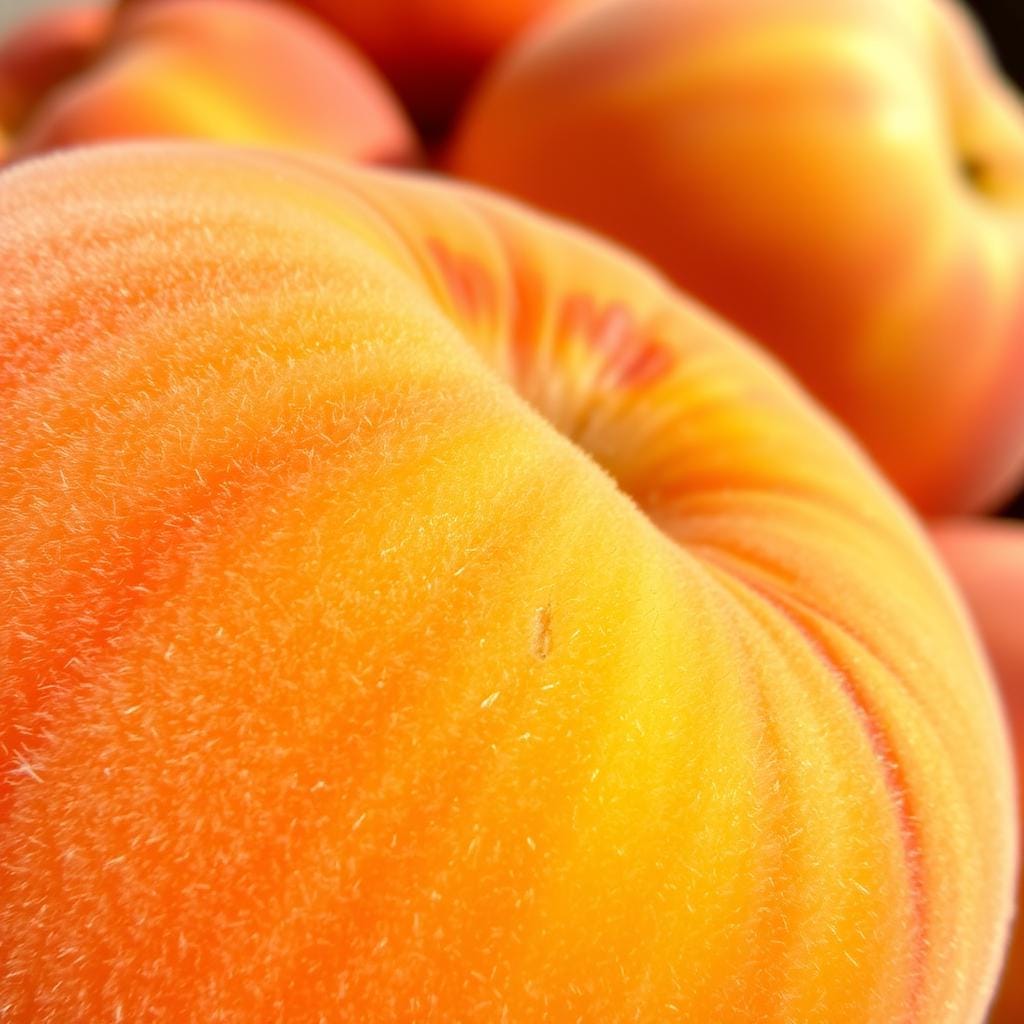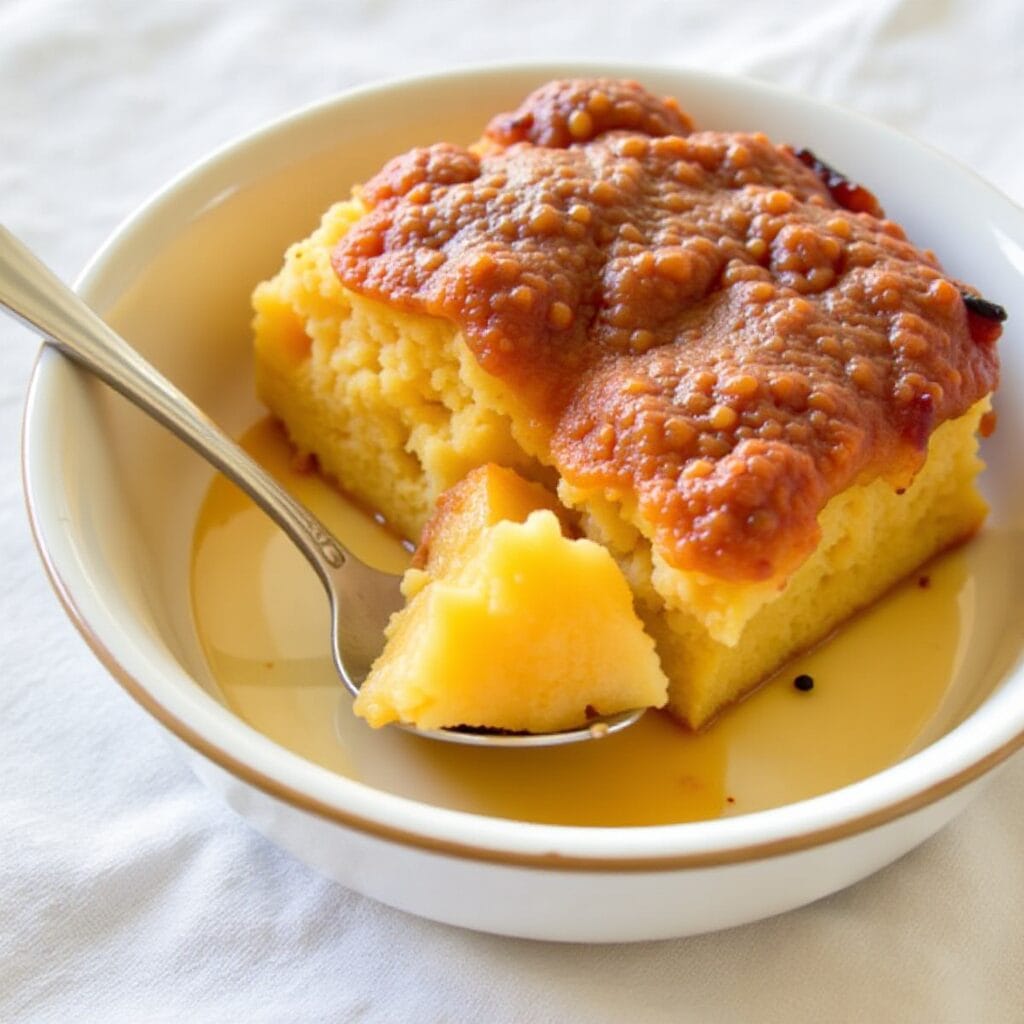What happens if you don’t peel peaches for cobbler? As a passionate home baker, I’ve discovered that imperfections make a dish special. Peach cobbler, with its comforting summer warmth and tradition, is no exception. Using unpeeled peaches brings a unique flavor and texture that’s hard to achieve with peeled fruit.
In this article, we’ll explore baking with unpeeled peaches. We’ll see how this choice can turn a classic cobbler into a masterpiece. You’ll learn about the science behind the skin’s effect and the nutritional benefits. This will help you make a better cobbler.

Key Takeaways
- Baking with unpeeled peaches can enhance the overall texture and flavor of your cobbler.
- Unpeeled peaches offer unique nutritional benefits that can’t be found in their peeled counterparts.
- Preparing and baking with unpeeled peaches can save time and streamline your cobbler-making process.
- Selecting the right peaches and following best practices can ensure a perfect cobbler texture with unpeeled fruit.
- Addressing common concerns about using unpeeled peaches can help you embrace this technique with confidence.
Let’s dive into the world of unpeeled peach cobbler. Here, imperfections become the key to a memorable dessert. Baking with peach skins has never been more delicious!
The Great Peach Cobbler Debate: To Peel or Not to Peel
Preparing peaches for cobbler has sparked many debates. As you explore the history of peach desserts, you’ll see how opinions on peeling have changed.
Historical Perspectives on Peach Preparation
Long ago, peeling peaches was seen as essential for a smooth texture. People thought the fuzzy skin was a problem. But now, many prefer to use unpeeled peaches in their fruit cobbler toppings.
Traditional vs. Modern Approaches
Peeling peaches is still common, but leaving the skin on is gaining fans. This method saves time and keeps the fruit’s natural taste and texture. It makes the cobbler look and taste better.

“The skin adds a lovely chew and subtle bitterness that complements the sweetness of the peach filling perfectly.”
Both old and new ways of preparing peaches have their fans. This lets home cooks make the cobbler their own, based on their taste and style.
Understanding Peach Skin Composition and Texture
When making peach cobbler, the debate about peeling peaches is ongoing. Knowing about peach skin’s composition and texture can help. It sheds light on the benefits of leaving the skin on during baking.
Peach skin is made up of important parts that make it special. It has more dietary fiber, which improves the cobbler’s texture. It’s also packed with antioxidants, vitamins, and minerals, adding nutrition to your dessert.
- Peach skin is rich in vitamin C, boosting your immune system.
- It’s also full of carotenoids, like beta-carotene, offering health benefits.
The peach skin texture is soft and slightly fuzzy. It adds a unique feel to your dessert. This texture contrasts beautifully with the peach’s soft flesh, making each bite enjoyable.

Knowing about peach skin’s makeup and feel helps you decide whether to peel or not. Your choice depends on what you like best. But, leaving the skin on can add both nutrition and texture to your peach cobbler.
What Happens If You Don’t Peel Peaches for Cobbler?
When making a classic peach cobbler, the debate on peeling peaches is common. Some like the smooth texture of peeled peaches. Others think the skins make it better. So, what happens if you skip peeling peaches for your cobbler?
Texture Changes During Baking
Using unpeeled peaches changes the cobbler’s texture. The skins soften and mix into the filling. This adds a chewy feel and a heartier taste.
Impact on Overall Taste
Leaving the skins on also changes the taste. The skin holds more of the peach’s oils and smells. This makes the fruit sweeter and the peach flavor stronger.
Visual Appearance Considerations
Unpeeled peaches make the cobbler look more vibrant and appealing. The skins add color that contrasts with the crust and filling. This makes the dish look homemade and special.
Whether to peel or not peel peaches is up to you. It depends on what you like in your cobbler. Knowing how unpeeled peaches affect the dish helps you choose what’s best for your recipe.
Nutritional Benefits of Keeping Peach Skins
Deciding to peel or not peel peaches can change your peach cobbler’s nutritional value. Peeling peaches is common, but keeping the skins offers health benefits. These benefits are worth considering.
Peach skins are rich in dietary fiber. This fiber helps with digestion and keeps you feeling full. So, eating unpeeled peach cobbler can boost your fiber intake.
The skins of peaches are also packed with vitamins and antioxidants. Peach skins have more vitamins A and C, and beneficial compounds like carotenoids and polyphenols. These can support your health and well-being.
- Peach skins are a good source of fiber, which supports digestion and promotes feelings of fullness.
- The skins contain higher levels of vitamins A and C compared to the flesh of the peach.
- Peach skins are rich in antioxidants, such as carotenoids and polyphenols, that can provide health benefits.
Choosing to bake with unpeeled peaches saves time and adds nutrients to your peach cobbler. Next time, leave the skins on for a healthier and tastier treat.
Time-Saving Advantages of Unpeeled Peaches
Choosing to use unpeeled peaches can greatly speed up your baking. It makes preparing peach desserts quicker and more efficient. This approach saves you time in the kitchen.
Streamlining Your Baking Process
Peeling peaches takes a lot of time, especially for big batches. Skipping this step with unpeeled peaches saves minutes. This means you can get your desserts in the oven faster.
It also cuts down on the effort needed to put your recipe together. This is especially true for peach cobbler and other peach treats.
Kitchen Efficiency Tips
- Eliminate the peeling step to save time and energy.
- Prepare your peaches more quickly by simply rinsing, pitting, and slicing them.
- Reduce the number of tools and equipment needed, as you won’t require a peeler or paring knife.
- Spend less time on the peach dessert preparation and more time on the enjoyable aspects of baking, such as mixing, assembling, and decorating your creations.
Using baking with peach skins makes your kitchen work smoother. It lets you focus more on making delicious peach desserts. Discover how unpeeled peaches can make your baking better.
How to Prepare Unpeeled Peaches for Cobbler
Choosing to use unpeeled peaches in your peach cobbler recipe can greatly enhance the dish. Here are a few easy steps to prepare them perfectly.
- Begin by rinsing the peaches under cool water. This removes dirt and residue.
- Then, cut the peaches into even pieces, keeping the skin on. The skin adds a unique texture to your cobbler.
- If the skins are thick, blanch them in boiling water for 30-60 seconds. This softens them before baking.
- Finally, pat the peach slices dry with a towel or paper towels. Be gentle to avoid removing the peels.
By following these steps, you’ll create a delicious peach cobbler. It will have soft fruit and a nice texture from the unpeeled skins.
“The best part about using unpeeled peaches is the extra burst of flavor and texture they add to the cobbler.”
Remember, clean and evenly slice the unpeeled peaches for the best results. This technique saves time without sacrificing flavor in your peach cobbler recipe.
Best Practices for Baking with Unpeeled Peaches
Baking a peach cobbler without peeling the fruit can be a delightful experience. To get the best results, follow a few simple steps. These adjustments will help you create a dessert that highlights the peach skins’ natural beauty and flavor.
Temperature Recommendations
When baking with unpeeled peaches, the oven temperature is crucial. To avoid tough or chewy peach skins, bake at a slightly lower temperature. Aim for 375°F (190°C) to soften the skins and blend them into the dish.
Cooking Time Adjustments
Adjusting the cooking time is also important. Unpeeled peaches take longer to soften. Add 10-15 minutes to your usual baking time. Keep an eye on the cobbler as it cooks. You want a tender filling with peach skins that melt into the texture.
By following these tips for baking with peach skins, you can make a peach cobbler recipe that’s both beautiful and delicious. It won’t sacrifice texture or taste.
Selecting the Right Peaches for Unpeeled Cobbler
Choosing the right peaches is key for a tasty peach cobbler without peeling. Not all peaches are the same. Knowing their differences can help you make the best unpeeled cobbler.
Here are some tips for picking the perfect peaches:
- Ripeness: Pick peaches that are ripe but still firm. Too ripe or soft peaches can make your cobbler mushy.
- Variety: Look for peaches with thin, delicate skin. Elberta or Redhaven are good choices. They soften well in the cobbler without getting tough.
- Quality: Choose peaches that are free of blemishes and bruises. Better peaches mean a more delicious cobbler.
By following these tips, you’ll make a peach cobbler that’s full of flavor. You won’t need to peel the peaches for this.
Common Concerns About Using Unpeeled Peaches
Using unpeeled peaches in baking can raise some questions. Let’s look into a few of these concerns. We’ll see why the peach skin is a good choice for your cobbler.
Bitterness and Toughness
Some worry that unpeeled peaches might taste bitter or be tough. But, this is usually not true. The peach skins can make your cobbler taste sweeter and have a nice chewiness.
Digestive Issues
Others might think the peach skin could upset their stomach. But, the peach skin texture is easy to digest. It also adds fiber, which is good for your gut.
“I was hesitant to use unpeeled peaches at first, but after trying it, I was pleasantly surprised by the depth of flavor and the perfect texture it added to my cobbler.”
Appearance Concerns
Some might worry about how the cobbler looks with unpeeled peaches. The what happens if you don’t peel peaches for cobbler? is that it gets a rustic charm that many like.
By understanding these concerns, you can confidently use unpeeled peaches in your cobbler. You’ll enjoy the unique texture and flavor they add.
Tips for Perfect Cobbler Texture with Unpeeled Peaches
The texture of a fruit cobbler is crucial for a great dessert. Using unpeeled peaches can make it even better. Here are some expert tips to get the perfect consistency and moisture balance.
Achieving the Ideal Consistency
To get a smooth, velvety texture, try these adjustments:
- Use more thickening agents like cornstarch or flour to handle the extra moisture from peach skins.
- Coat the unpeeled peach slices with a bit of flour or cornstarch before adding them. This helps soak up extra liquid.
- Adjust the baking time and temperature. Unpeeled peaches might need a bit longer to set.
Balancing Moisture Levels
It’s important to keep the right moisture balance with unpeeled peaches. Here are some tips:
- Use less added liquid like water or fruit juice in the filling. The peach skins will release their own juices.
- Choose a thicker topping, like a biscuit crust, to soak up extra moisture from the peaches.
- Try mixing fresh and dried fruit toppings to find the perfect moisture balance.
By using these expert tips, you can make a delicious fruit cobbler with unpeeled peaches. It will have a perfect texture and moisture level. Enjoy the sweet, juicy peaches and the rich cobbler topping together.
Conclusion
In our journey through peach cobbler, we’ve looked at the debate about peach skin. We’ve seen how using unpeeled peaches can make your cobbler better. This includes more nutrients and saving time.
By following the right steps, you can make your peach cobbler perfect. It will have great texture, taste, and look. Whether you’re experienced or new to baking, try using unpeeled peaches. It’s a fun way to explore new flavors.
So, when you want peach cobbler, use unpeeled peaches. They add something special to your dish. Enjoy making your peach cobbler and share it with others. It will surely impress everyone.

